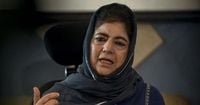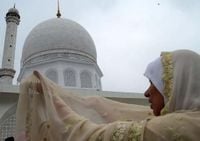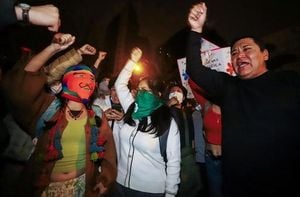The Hazratbal shrine in Srinagar, long revered as a sanctuary of faith and a symbol of Kashmiri heritage, has recently found itself at the epicenter of a controversy that has rippled through religious, political, and legal circles across India. What began as a celebration of restoration and renewal has, within days, transformed into a flashpoint over the boundaries between state authority and religious autonomy, igniting fierce debates about secularism, constitutional rights, and the very soul of the nation.
On September 3, 2025, the Jammu and Kashmir Waqf Board inaugurated the newly renovated Hazratbal Shrine. The event was marked by the unveiling of a marble plaque bearing the national emblem of India—the Ashoka pillar—and the name of Darakhshan Andrabi, the chairperson of the Waqf Board. According to News Arena Network, the inclusion of the emblem was intended to symbolize unity and the state’s commitment to preserving cultural heritage. However, the move quickly drew the ire of many in the Valley, with critics asserting that the emblem’s presence inside the revered site was both provocative and blasphemous.
Just five days after the inauguration, on September 8, the plaque was vandalized by an angry crowd. The Ashoka emblem, meant to represent the sovereignty of the Republic, was torn down within the shrine’s sacred walls. The images of the defaced plaque spread rapidly, unsettling not only the religious sensibilities of the faithful but also the civic pride of the nation. The act of vandalism, as reported by Basarat Bashir in an analysis published on September 10, 2025, “crossed that boundary” between legitimate religious grievance and disrespect for national symbols.
The incident triggered a wave of detentions and police action. Authorities intensified their search for those responsible, detaining dozens for questioning. A senior police officer told News Arena Network that legal action would be taken against those involved, with the exception of minors. The official stressed, “action as per law will also be taken against women who vandalised the plaque, but any minor found involved in the incident will not be proceeded against.”
Outrage spilled into the streets and onto social media. Political parties across the spectrum, religious clergy, and civil society groups condemned both the placement of the emblem and its subsequent defacement. Women protesters accused Darakhshan Andrabi of facilitating an “anti-Muslim and blasphemous act” and demanded her apology and the immediate removal of the emblem. Their fears, amplified by recent verdicts such as the Babri Masjid case and amendments to Waqf laws, centered on the possibility that such actions could set a troubling precedent for future state interventions in religious spaces.
The controversy drew sharp responses from political leaders. Omar Abdullah, former Chief Minister of Jammu and Kashmir, called for the Waqf Board to apologize for what he termed a “mistake.” He asserted, “the national emblem is meant for government functions, not religious institutions,” and added, “mosques, shrines, temples and gurdwaras are not government institutions. These are religious institutions, and government emblems are not used in religious institutions.” The National Conference (NC), Peoples Democratic Party (PDP), and the Communist Party of India (Marxist) echoed this sentiment, labeling the use of the Ashoka emblem inside the mosque as “provocative” and “blasphemous.”
On the other side, Darakhshan Andrabi, a BJP appointee, demanded stringent legal action against those who vandalized the plaque, including booking the “hooligans” under the Public Safety Act (PSA). The BJP condemned the defacement, emphasizing the importance of respecting national symbols and state authority.
Mehbooba Mufti, president of the PDP and former Chief Minister, voiced her concerns on September 10, 2025, urging the Lieutenant Governor Manoj Sinha-led administration to release those detained in connection with the Hazratbal incident, including sitting Doda MLA Mehraj Malik. Mufti argued that the use of the PSA against an elected representative was unjustified, stating, “PSA is not warranted for a people’s representative even if he has used some offensive language against government officials. Such arrests erode democracy and restrict people from expressing themselves.” She further alleged that Malik’s arrest was a tactic to divert public attention from the Hazratbal shrine controversy, warning that restricting people’s voices, as seen in Sri Lanka, Bangladesh, and Nepal, can have serious consequences.
The heart of the controversy lies in the collision of two powerful symbols: the national emblem, representing the sovereignty of the Republic, and the sanctity of a religious shrine, embodying the sovereignty of faith. As Basarat Bashir explains, Islam’s core principle of tawheed—the oneness of God—rejects the placement of figurative or representational symbols in places of worship. For many, the presence of the Ashoka emblem inside Hazratbal was a violation of this spiritual tenet. Yet, the national emblem is not an idol; it is a mark of state authority. Its desecration, therefore, is not merely a religious protest but also a legal offense under laws protecting state symbols.
The Indian Constitution offers guidance, though not always clear answers. Articles 25 and 26 guarantee religious freedom and the autonomy of denominations to manage their own affairs. The Supreme Court’s landmark Shirur Mutt case (1954) established that essential religious practices are to be defined primarily by the community of the faithful. At the same time, Article 51A(a) of the Constitution imposes a duty on every citizen to respect the Constitution and its symbols. The Supreme Court, in Bijoe Emmanuel (1986), ruled that respect for national symbols need not always be expressed through conformity, but must never descend into contempt.
Hazratbal’s predicament, as Bashir notes, lies in this constitutional grey zone. The state’s attempt to assert its presence in a sacred space was seen as overreach, while the violent response was a rejection of civic respect. Both actions, he argues, weaken the secular compact envisioned by Mahatma Gandhi—a compact built not on the exclusion of religion from public life, but on mutual respect and restraint.
The incident has reignited broader anxieties in Kashmir, where recent legal and political developments have left many in the Muslim community feeling vulnerable. The demand for dialogue and mutual understanding has become more urgent than ever. As Bashir writes, “the emblem and the shrine need not be adversaries. One embodies the majesty of the state, the other the majesty of the divine. Each has its rightful space; neither should colonise the other.”
As authorities continue their investigation and public debate rages on, the broken marble plaque at Hazratbal stands as a fractured metaphor for the delicate balance between faith and sovereignty in India. The lesson from Hazratbal is clear: only through humility, dialogue, and restraint can the nation’s secular compact endure in the face of such trials.





